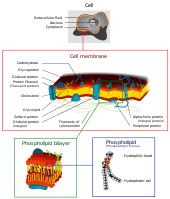
Photo from wikipedia
Carbon-fiber microelectrodes have proven to be an indispensable tool for monitoring exocytosis events using amperometry. When positioned adjacent to a cell, a traditional microdisc electrode is well suited for quantification… Click to show full abstract
Carbon-fiber microelectrodes have proven to be an indispensable tool for monitoring exocytosis events using amperometry. When positioned adjacent to a cell, a traditional microdisc electrode is well suited for quantification of discrete exocytotic release events. However, the size of the electrode does not allow for intracellular electrochemical measurements, and the amperometric approach cannot distinguish between the catecholamines that are released. In this work, carbon nanoelectrodes were developed to permit selective electrochemical sampling of nanoscale vesicles in the cell cytosol. Classical voltammetric techniques and electron microscopy were used to characterize the nanoelectrodes, which were ~5 microns long and sharpened to a nanometer-scale tip that could be wholly inserted into individual neuroendocrine cells. The nanoelectrodes were coupled with fast-scan cyclic voltammetry (FSCV) to distinguish secretory granules containing epinephrine from other catecholamine-containing granules encountered in the native cellular environment. Both vesicle subtypes were encountered in most cells, despite prior demonstration of populations of chromaffin cells that preferentially release one of these catecholamines. There was substantial cell-to-cell variability in relative epinephrine content, and vesicles containing epinephrine generally stored more catecholamine than the other vesicles. The carbon nanoelectrode technology thus enabled analysis of picoliter-scale biological volumes, revealing key differences between chromaffin cells at the level of the dense-core granule.
Journal Title: ACS nano
Year Published: 2020
Link to full text (if available)
Share on Social Media: Sign Up to like & get
recommendations!